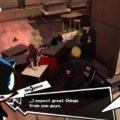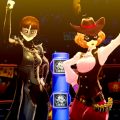Cognition Dissemination: No More Japanese RPGs With Only One Main Battle Theme

Consider a scenario with me. Say you’re playing a Japanese RPG, just getting into the groove of its battles. The first time you hear the battle theme, the lyrics beginning with, let’s say, “Baby Baby Baby,” you think it’s the catchiest theme around. It’s still catchy around 20 hours later, because good game composers aim to ensure their battle themes can be heard countless times without becoming grating. But it’s around the 60-hour mark that “Baby Baby Baby” starts wearing you down when part of the same battle theme over and over again. By the time you’re 80 hours in, you are now rolling your eyes at the mere thought of hearing it again.
This is too prevalent of a problem in Japanese RPGs, the examples that swear by sticking with the exact same main battle theme for the entire game duration. It doesn’t matter how good the theme is, or how much care the composer put into it. Even the best theme will get grating by a certain point. This has never been the biggest issue with the genre over the years, but this one has remained in the back of my mind for a while. Soundtracks for video games have become more varied over the years, alongside the games themselves become longer, which JRPGs being one of the biggest examples. Yet too many in the genre swear by the logic of using the same battle theme for hours upon hours, sometimes despite their large soundtracks. It’s time for a change.
The example in the lede is from Persona 3’s Mass Destruction, and anyone who played through that game’s 100(-plus) hours of content will be too familiar with the theme. It never changes after all that time, and themes with prominent lyrics start grating that much faster. But it’s largely forgivable in this case because Atlus was a very niche development company at the time, and couldn’t afford to give this game that big of a soundtrack. Persona 3 was the title that made the Persona series popular with a wider audience.

Now that it is popular, there’s no excuse. I couldn’t tell you the number of times I said “You’ll never see it comiiiiiing” with Persona 5’s main battle theme, Last Surprise — with precisely that emphasis. But after about 80 hours, I’d had enough of it, in a game that took me about 120 to finish. I, essentially, saw it coming too often. The Persona brand has become very popular over the years, and it now qualifies as one of the top JRPG franchises around thanks to Persona 5 selling millions worldwide. It’s unforgivable in this case that it swears by one battle theme for the whole playthrough. This becomes a bigger problem when the theme doesn’t fit the mood and music theme for later dungeons, especially the final one around that 120-hour point.
Persona 5 Royal adding a new battle theme in addition to keeping the old one wasn’t quite enough to fix the precise issue laid out in the last paragraph, but the practice of the upgraded versions adding the much-needed variety is enough to make me a full cynic. They’ve now done this for two straight games (also with Persona 4 to Persona 4 Golden), making it clear that Atlus’ strategy is to get hardcore fans to buy both versions or, perhaps more wisely, wait for the updated versions for more battle theme variety if they have the willpower. (I’m clearly not talking about myself there.) It’s always nice when you pay for it twice.
In non-Persona examples: This is largely the case with Dragon Quest XI, which relies on the same battle theme for its very long duration, including the important post-game content. There are, to be fair, certain points where a different battle theme will play, but those are few and far between. DQXI is a particularly virulent offender because its theme isn’t good enough to be listened to several times even after around 30 hours (a generous estimate), because Koichi Sugiyama’s composition skills have waned over the years. The orchestral version is an improvement over the original mdi synthesizer-powered one, but not enough of one when the composition quality is the issue. Sugiyama has been the sole composer for the franchise since Dragon Quest’s inception, a franchise dedicated towards maintaining tradition. There was no chance of them switching him out or giving him help unless he requested it.
(I would like to think Sugiyama being an aging bigot and war crimes denier is part of the issue, but there’s no evidence suggesting this is the case. There’s no evidence suggesting this isn’t the case, either.)

It’s not all bad here. There are several counterexamples the grievous offender JRPGs should aspire to reach, if not match. Final Fantasy XV is one of the best examples, which has a whopping eleven standard battle themes depending on the area and point of the game the player is in. That’s somehow not including the boss themes. The number was so high that I had to look them up to count. I’m aware FFXV is a big budget example, the likes of which most developers would love to have even a portion of the production values of, but it’s the RPG example where it feels like the development team made a conscious effort to avoid the problem I’m discussing here. The same applies with the Kingdom Hearts series, battle themes in which change depending on the area.
But it’s not like smaller games haven’t done this, even though their numbers can’t hope to match the variety in FFXV and the KH series. Shin Megami Tensei III: Nocturne, which originally released on PlayStation 2 and the remaster for which releases in western territories in late May, has five battle themes depending on the area. One of those was added to the updated “Maniax” version released on PS2 in Japan (the first version localized in English), but even four was enough to offer variety. Speaking of four: Shin Megami Tensei IV followed in this game’s footsteps by offering three main battle themes. The number wasn’t on par with this predecessor, but this was enough to prevent monotony. Atlus’ more successful once-a-spinoff Persona franchise could learn something from the Megaten series.
This is an issue I’m hoping developers will work to prevent in future JRPG efforts. There’s a reason why I named Persona and Dragon Quest here, the two biggest franchises that could easily afford to avoid it, though DQ is unlikely to do so until a certain tradition fades. If this can’t be done, alternate variations of the main battle theme will suffice, one containing subtle changes to fit an area or in-game story theme.
There will be lower-budget games that won’t have much choice but to swear by this trend, even though that won’t stop the tracks from becoming repetitive eventually. Every future JRPG with at least a mid-tier (or AA, if you prefer) budget will have no excuse when it comes to preventing this in future games, and I will roll my eyes hard at every one that does. I will put my large foot down if this continues, and they will damn-well hear it.





